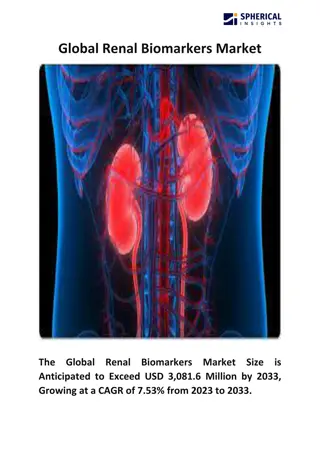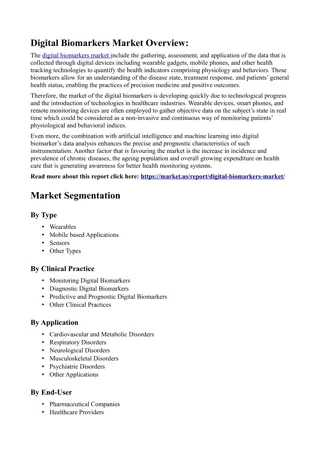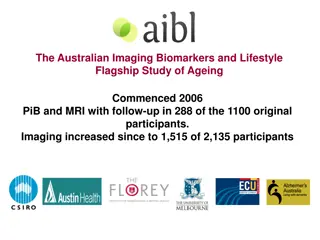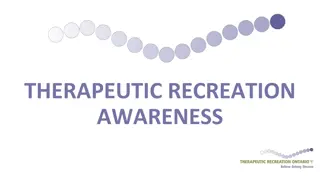Understanding Biomarkers in Therapeutic Innovation
European Patients Academy on Therapeutic Innovation explains how biomarkers are measurable indicators providing insights into health conditions. Biomarkers like glucose levels in diabetes management and MRI imaging for Multiple Sclerosis play crucial roles. The Academy aims to enhance the medicine development process by using biomarkers as surrogate endpoints, enabling faster decisions and ethical advantages. Validated biomarkers serve as valuable tools, impacting clinical trials and treatment approaches.
Download Presentation

Please find below an Image/Link to download the presentation.
The content on the website is provided AS IS for your information and personal use only. It may not be sold, licensed, or shared on other websites without obtaining consent from the author. Download presentation by click this link. If you encounter any issues during the download, it is possible that the publisher has removed the file from their server.
E N D
Presentation Transcript
European Patients Academy on Therapeutic Innovation Biomarkers
Biological Markers European Patients Academy on Therapeutic Innovation A biological marker is a measurable indicator that can tell us something about a person s health or disease state, for example, disease (pathological) processes in the body, for example, disease stage, biological processes in the body (heart rate, blood pressure, temperature), a person s response to a treatment or medicine, or a psychological condition. Biomarkers are used in many scientific fields, in different ways at different stages of medicines development. The accuracy of biomarkers can vary, therefore, not all biomarkers are suitable for medicines development. 2
Examples of Biomarkers European Patients Academy on Therapeutic Innovation Glucose levels that are used as a biomarker in managing diabetes. Brain images such as Magnetic Resonance Imaging (MRI) that can provide information about the progression of Multiple Sclerosis. biological substances such as enzymes, which may be found in the blood or in tissue samples and are often used in cancer research, genetic (DNA) changes, medical images, or X-rays. 3
Aims of Biomarker Use European Patients Academy on Therapeutic Innovation 1. Improving the processes of medicines development Clinical trials seek to measure patients responses to a treatment. If it is not possible to measure the response directly, biomarkers may provide an alternative way of measuring an outcome - they serve as surrogate endpoints. 4
European Patients Academy on Therapeutic Innovation There are advantages of using validated biomarkers as surrogate endpoints, they might be able to be measured earlier, more easily, or frequently, with high precision; they may be less affected by other treatments, reduce the sample size required, and allow researchers to make faster decisions; they offer important ethical advantages as surrogate endpoints in diseases with poor prognoses. 5
Example of the use of a biomarker as a surrogate endpoint European Patients Academy on Therapeutic Innovation An example of the use of a biomarker as a surrogate endpoint comes from the development of antiretroviral medicines for HIV and AIDS. Previously, studies would have been based on hard clinical endpoints such as the progression of the HIV infection to AIDS and/or patient survival. Now, cell changes such as levels of CD4 lymphocytes and changes in the levels of HI-virus RNA in plasma can be used as surrogate endpoints. 6
Aims of Biomarker Use European Patients Academy on Therapeutic Innovation 2. Tailoring treatment to individuals Biomarker research is helping to improve how well we can predict a person s risk of disease, how a disease might progress once it is diagnosed, how an individual will respond to a medicine. This will enable safer and more effective treatment decisions. Examples: Blood sugar levels in a patient s blood can be used to monitor if an individual is responding to diabetes treatment. Magnetic Resonance Imaging (MRI) scans of a patient s brain can be used to monitor the progress of the disease in Multiple Sclerosis. 7
European Patients Academy on Therapeutic Innovation Many new biomarkers are being discovered and used during the development of new medicines. Many of these use: genomics (analyses of changes occurring at the gene level), proteomics (analyses of changes on the protein level), and/or metabolomics (analyses of differences in chemical molecules that play an important role in body and cell function). 8
Biomarkers in Medicines Development European Patients Academy on Therapeutic Innovation Cancer (oncology) research was one of the first areas where the use of biomarkers was adopted. Biomarkers are used to make exploratory trials and Phase II trials ( Proof of Concept trials) of medicines more efficient. Only a limited number of biomarkers can be used for clinical endpoints in Phase III trials (confirmatory trials). Biomarkers may be used in late-stage trials in combination with clinical outcomes (clinical endpoints). 9
European Patients Academy on Therapeutic Innovation For some medicines, only a minority of patients might respond. It is helpful to identify these patients for clinical trials using biomarkers. 10
Companion Diagnostics European Patients Academy on Therapeutic Innovation Companion diagnostics are tests that are validated and approved for marketing alongside a new medicine. These tests may help to: select patients likely to respond to a medicine, exclude those patients likely to have an adverse reaction, and determine the best dose for a patient. 11
Companion Diagnostics European Patients Academy on Therapeutic Innovation Many companies developing targeted therapies for cancer have also begun to consider the potential benefits of developing a diagnostic to pair with that treatment. The trend is to develop medicines and companion diagnostics together, rather than have both developments happen separately. 12
Biomarkers potential to increase the efficiency of medicines development European Patients Academy on Therapeutic Innovation Speeding up clinical trials Biomarkers can be used to detect an effect (or lack of effect) earlier and more frequently than if only a clinical outcome (endpoint) is used. Example: a panel of biomarkers has been used in the early phases of a clinical trial for a psoriasis treatment. The biomarkers included epidermal thickness (thickness of the outer layer of skin) and the activity levels of several genes. These were both measured in tissue samples. 13
Biomarkers potential to increase the efficiency of medicines development European Patients Academy on Therapeutic Innovation Streamlining clinical trials Biomarkers are used to identify those patients who are most suitable for a treatment, specifically, genomic biomarkers can be used to: identify patients with a particular disease sub-type or severity, exclude patients at increased risk of serious side effects (adverse reactions), for example, melanoma patients are at risk of their condition getting worse if their tumours do not have a certain mutation in the BRAF gene and they are treated with kinase inhibitors, identify patients with a high chance of benefiting from a particular medicine. 14
Biomarkers potential to increase the efficiency of medicines development European Patients Academy on Therapeutic Innovation Improve our understanding Biomarkers can improve understanding of how new medicines work and may lead to novel approaches to medicines development in both non-clinical and clinical phases Improving the ethics of trial recruitment Biomarkers can help exclude people who won t benefit from starting a non-helpful treatment, thus providing an ethical benefit. Improving trial monitoring and stopping unhelpful trials early Biomarkers may help decide whether to stop a trial early if there is no benefit to be gained by the patients in the trial or an obvious benefit where withholding treatment would be unethical. 15
Biomarkers potential to increase the efficiency of medicines development European Patients Academy on Therapeutic Innovation Speeding up authorisation A medicine that is having a positive effect may be authorised sooner based on information provided using biomarkers and therefore may be prescribed earlier to patients who will benefit. 16
Challenges of using biomarkers in medicines development European Patients Academy on Therapeutic Innovation As the use of biomarkers in pharmaceutical research grows, companies face new technical challenges, regulatory challenges, ethical challenges. 17
Technical Challenges European Patients Academy on Therapeutic Innovation Biomarkers used in clinical trials must be validated through scientific evidence to ensure that the biomarker test is sufficiently accurate, reliable, sensitive, and specific. The biomarker needs show a reasonable relationship to the disease being studied. If a biomarker is used to predict how severe a disease may become, is there enough evidence of the predictive ability with this biomarker? 18
Technical Challenges European Patients Academy on Therapeutic Innovation IT systems for data management and data analysis must be reliable and fast to cope with the amount of data generated. All biomarker measurements must be correctly linked with individual patients. Where the use of a companion diagnostic is required for a new medicine to be prescribed, a new platform or kit for testing patients in the clinic may need to be developed. 19
Regulatory Challenges European Patients Academy on Therapeutic Innovation The regulation of the use of novel methods such as biomarkers in medicines development is evolving. Biomarker and surrogate endpoint are not interchangeable terms. For a biomarker to be used as a surrogate endpoint, studies will be done to assess the direct relationship of the biomarker with: the development of the disease, a treatment intervention with an important clinical endpoint. 20
Regulatory Challenges European Patients Academy on Therapeutic Innovation Developers of novel biomarkers are being encouraged to engage with regulators at an early stage. They can submit their plans to use biomarkers to the EMA. Validating biomarkers to meet regulatory standards can be complex and expensive. This is especially challenging if a biomarker is intended to be used as a surrogate endpoint. In this case, a dedicated clinical trial is required, designed to test the link between the biomarker and the clinical endpoint. 21
Regulatory Challenges European Patients Academy on Therapeutic Innovation In the EU, medicines and diagnostics are regulated differently. Licensing a medicine and its companion diagnostic together adds an extra layer of complexity to the approval process. 22
Ethical Challenges European Patients Academy on Therapeutic Innovation Many of the ethical issues that arise in biomarker research are linked to the storage and use of tissue samples and the associated handling of personal medical data. Wider concerns have been raised about the impact of targeted medicine (which is largely based on biomarker research). As targeted treatments only bring benefits to the sub- population of patients that respond to them, the challenge is to ensure that medicines are developed for those who fall outside of this sub-population. 23
References European Patients Academy on Therapeutic Innovation Industry Pharmacogenomics Working Group (2012). Understanding the intent, scope, and public health benefits of exploratory biomarker research. A guide for IRBs/IECs and investigational site staff. Retrieved 1 September, 2015 from http://i- pwg.org/index.php?option=com_docman&task=doc_dow nload&gid=187&Itemid=118 24























